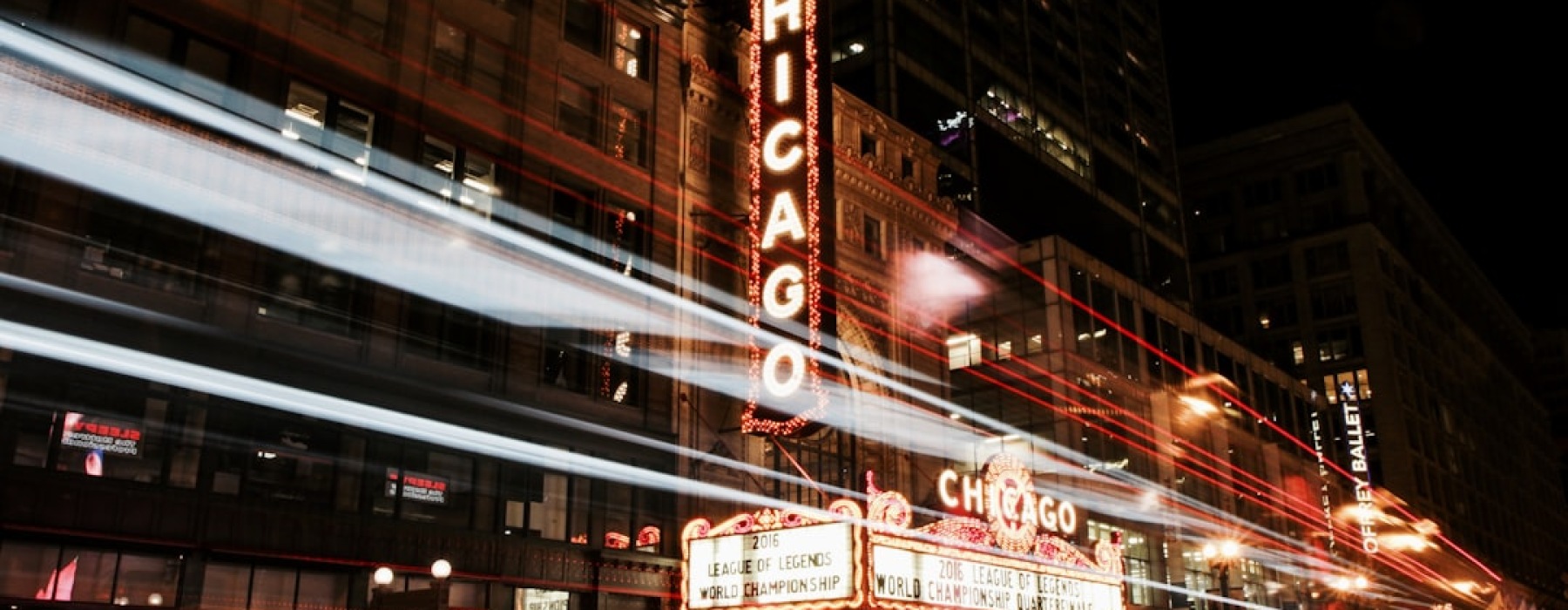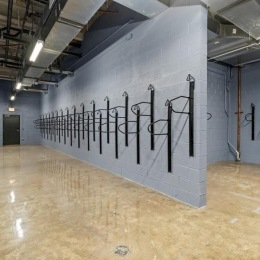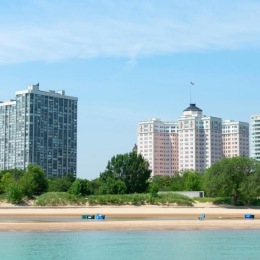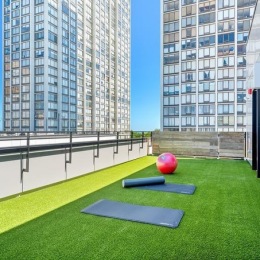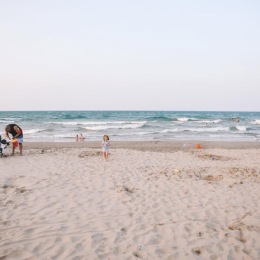The Pink Palace by the Lake: Chicago's Lost Resort
Rising majestically along Chicago's northern shoreline, the Edgewater Beach Hotel Chicago once stood as a testament to luxury, leisure, and lakeside living. This beloved landmark operated from 1916 to 1967, and though it disappeared from the skyline over five decades ago, it remains firmly anchored in the city's collective memory.
When the original 400-room building opened its doors on June 3, 1916, Chicagoans had never seen anything quite like it. The hotel expanded dramatically in 1924 with a 19-story tower adding 600 more rooms, bringing the total to an impressive 1,000 accommodations. Designed by the architectural firm Marshall & Fox in a romantic Spanish Revival style, the Edgewater Beach Hotel Chicago featured a unique Maltese cross layout that maximized lake views from every possible angle. Its "sunrise yellow" stucco exterior made it instantly recognizable to anyone traveling along the lakeshore.
What truly set this urban oasis apart was its spectacular 1,200-foot private beach on Lake Michigan. Hotel guests enjoyed amenities that seemed almost magical for city living: seaplane service whisking visitors downtown, broadcasts from the hotel's own radio station (WEBH, which later evolved into WGN), and the world's first indoor parking garage. The neat dining rooms could accommodate up to 1,200 guests for grand events, while strict dress codes maintained the atmosphere of exclusivity and refinement.
The guest register read like a who's who of 20th-century America. Babe Ruth checked in when the Yankees played in Chicago. Marilyn Monroe graced the hallways. Frank Sinatra crooned in the ballrooms. Even Martin Luther King Jr. stayed at the hotel during visits to the city.
The hotel's fortunes took a dramatic turn when the extension of Lake Shore Drive in the early 1950s physically cut the property off from its namesake beach. This infrastructure change—separating the "Beach Hotel" from the actual beach—marked the beginning of a slow decline. Struggling with changing travel patterns and increasing competition from downtown properties, the once-glamorous destination closed its doors in December 1967 and was demolished by 1971.
Today, the only physical remnant of this grand complex is the "sunset pink" Edgewater Beach Apartments building, constructed in 1928 as part of the hotel complex and now listed on the National Register of Historic Places. While the hotel itself may be gone, its legacy continues through historical exhibits, vintage postcards, and the memories of Chicagoans who still speak of the "Pink Palace" with genuine affection and pride.

Edgewater Beach Hotel Chicago: A Lakeside Icon
The Edgewater Beach Hotel Chicago graced the intersection of Berwyn Avenue and Sheridan Road with an elegance rarely seen in urban architecture. Crafted by Marshall & Fox (the same visionaries who created the Drake Hotel), this lakeside gem sat just 20 feet from Lake Michigan's shimmering waters, giving guests front-row seats to nature's daily spectacle.
When it welcomed its first visitors on June 3, 1916, the original structure boasted 400 rooms thoughtfully arranged in a croix fourchée (forked cross) pattern. This clever design wasn't just for show—it ensured that as many guests as possible could wake up to breathtaking lake views. The price tag? A whopping $9 million—a fortune in those days that speaks volumes about the no-expense-spared approach to creating this lakeside haven.
Success came quickly, and by 1924, the hotel sprouted upward with a stunning 19-story south tower, affectionately dubbed "the Annex." This addition brought 600 more rooms to the property, connected to the original building by an neat corridor known as the "Passaggio." With 1,000 total rooms, the Edgewater Beach Hotel Chicago stood as one of the city's grandest accommodations.
You couldn't miss the hotel's "sunrise yellow" stucco exterior—a cheerful guide against Chicago's sometimes gray skyline and the deep blue of Lake Michigan. Architectural historians often note that "Benjamin Marshall's greatest hotel accomplishment was arguably the Edgewater Beach complex (1916-28), of which he was president." The property masterfully blended vacation vibes with metropolitan convenience, creating something truly special in the Chicago landscape.
What Made Edgewater Beach Hotel Chicago Unique?
What set the Edgewater Beach Hotel Chicago apart wasn't just its luxury—it was the unexpected vacation experience tucked into city limits. While downtown hotels catered to briefcase-toting business travelers, the Edgewater Beach offered a genuine resort experience without leaving Chicago's accept.
The hotel's showstopper was undoubtedly its 1,200-foot private beach. Imagine stepping from your room to feel sand between your toes within minutes—a true luxury for city dwellers. The beach scene was straight out of a postcard, with colorful umbrellas dotting pristine sands and attentive staff ensuring every comfort was met.
For guests needing to zip downtown, the hotel offered perhaps the most glamorous commute in Chicago history: seaplane service. While others sat in traffic, Edgewater guests could soar above Lake Michigan, landing downtown in minutes—talk about arriving in style!
The Edgewater Beach Hotel Chicago also made its mark on American culture as the birthplace of radio station WEBH (which later became WGN). Broadcasting antennas crowned the hotel tower, and the sounds of live jazz and big band performances from the hotel's ballroom reached ears across the Midwest, turning the hotel into a cultural tastemaker.
Innovation continued with what many consider the world's first indoor parking garage—a welcome feature during Chicago's notorious winters. And the hotel maintained standards as high as its tower, with a strict dress code that kept flip-flops firmly on the beach and proper attire in dining areas. Women weren't initially allowed at the hotel bar—a reminder of how times have changed since those early days.
How to Visit the Site of Edgewater Beach Hotel Chicago Today
Though the hotel has faded into Chicago's storied past, you can still connect with its legacy by visiting the Edgewater Beach Apartments at 5555 N. Sheridan Road. This "sunset pink" co-op building, constructed in 1928 as part of the hotel complex, stands as the sole surviving structure from this once-magnificent property and proudly holds a spot on the National Register of Historic Places.
The X-shaped building's distinctive pink façade continues to catch the eye, while its lobby retains many original touches that whisper stories of glamorous bygone days. Around the building, you can stroll through remnants of the hotel's once-expansive gardens, now more modest but still beautiful.
Ironically, the Lake Shore Drive extension that contributed to the hotel's downfall now provides lovely public parkland with walking paths and lake views where the hotel once stood. The Edgewater neighborhood itself has blossomed in recent years, with new energy flowing into its streets through restaurants, shops, and contemporary living spaces.
The Edgewater Historical Society keeps the hotel's memory alive through fascinating exhibits featuring original hotel china, vintage postcards, and promotional materials. Their collection of photographs and oral histories offers a window into the glamorous world that once existed on this stretch of shoreline.
For those enchanted by the neighborhood's rich history, modern living awaits just steps from where the Edgewater Beach Hotel Chicago once stood. The Heron Apartments by Flats® offers today's residents the chance to create their own lakeside memories in this storied neighborhood, combining contemporary comforts with a location steeped in Chicago lore.
Golden Years: Amenities, Celebrities, and Cultural Impact
The Edgewater Beach Hotel Chicago truly earned its legendary status during its peak years from the 1920s through the 1940s. More than just a luxury hotel, it became the beating heart of Chicago's social scene—a place where history happened and memories were made.
At the center of the hotel's allure was its magnificent ballroom. With seating for 1,200 guests, this grand space featured sparkling chandeliers cascading from ornate ceilings, a professional-grade stage, and a specially designed sprung dance floor that seemed to energize dancers through the night. The ballroom hosted America's most beloved orchestras—Tommy Dorsey, Benny Goodman, Glenn Miller, and Artie Shaw all graced its stage, filling the space with the infectious rhythms of the swing era. Thanks to the hotel's pioneering radio broadcasts, these performances reached listeners across the Midwest, turning the Edgewater Beach Hotel Chicago into a cultural tastemaker.
The whimsically named Yacht Club brought maritime fantasy to the lakefront. Despite being firmly planted on solid ground, this clever venue transported guests to a luxury ocean liner through clever design touches—porthole windows offering glimpses of Lake Michigan, decorative ship's wheels adorning the walls, and staff dressed in crisp sailor-inspired uniforms. Guests would even board via a wooden gangway, cocktails in hand, completing the illusion of a night at sea.
When the Lake Shore Drive extension separated the hotel from its beloved beach in the early 1950s, management pivoted brilliantly by constructing an Olympic-sized swimming pool in 1953. This wasn't just any pool—it featured innovative underwater viewing windows (quite novel for the time), professional diving platforms, and attentive poolside service that maintained the resort atmosphere despite the hotel's changing relationship with the lakefront.
For guests seeking a taste of the exotic, the Polynesian Room offered a tropical escape without leaving Chicago. This tiki paradise rode the wave of mid-century Polynesian pop culture with bamboo furnishings, tropical cocktails served in carved coconuts, and performances that brought Pacific Island culture to the Midwest long before most Americans had traveled to Hawaii.
Active guests appreciated the hotel's tennis courts and compact golf course, allowing for recreation without venturing into the city. These amenities reinforced what made the Edgewater Beach Hotel Chicago special—a complete resort experience within city limits.
The guest register read like a time capsule of 20th-century celebrity. Babe Ruth and the New York Yankees made the hotel their Chicago home base, often seen relaxing poolside between games. Marilyn Monroe turned heads walking through the lobby during her film promotion visits. Frank Sinatra's performances packed the ballroom with adoring fans. Nat King Cole broke important racial barriers with his performances at the hotel when segregation still limited opportunities for Black performers.
American presidents chose the Edgewater Beach Hotel Chicago when visiting the Windy City, with both Franklin D. Roosevelt and Dwight D. Eisenhower enjoying its comforts. In a particularly significant moment, Martin Luther King Jr. delivered what he personally described as "the most significant and historic ever held for attacking racial injustice" during the 1966 Conference on Religion and Race hosted at the hotel.
The hotel even played a role in baseball lore when, on June 14, 1949, an obsessive fan named Ruth Ann Steinhagen shot Philadelphia Phillies first baseman Eddie Waitkus after luring him to her room. Waitkus survived the attack, and the incident later inspired Bernard Malamud's novel "The Natural," which became a classic baseball film starring Robert Redford.
Beyond entertainment, the Edgewater Beach Hotel Chicago influenced fashion and social trends throughout its golden years. Its strict dress codes (no gentlemen without jackets in the dining room!) and formal atmosphere set standards for Chicago's social elite, while its beach and poolside areas showcased the latest in resort wear and swimsuit fashion—photos from the era reveal how styles evolved from modest bathing costumes to more modern swimwear.
The hotel's cultural significance extended beyond its walls, broadcasting its sophisticated atmosphere across the nation and cementing Chicago's reputation as a city that could offer world-class luxury and entertainment. For decades, it remained the place to see and be seen—a pink-hued dream palace where everyday Chicagoans could brush shoulders with the famous while enjoying a level of service and amenities typically reserved for distant vacation destinations.
Today's residents at The Heron Apartments live just steps from where this cultural phenomenon once stood, continuing the neighborhood's tradition of lakeside living in modern luxury.
Turning Tides: Lake Shore Drive Extension and the Hotel's Decline
The glory days of the Edgewater Beach Hotel Chicago began to fade in the early 1950s when Chicago started on an ambitious infrastructure project that would forever alter the hotel's identity. The northward extension of Lake Shore Drive, built on landfill along the shoreline, severed the hotel's direct connection to its most precious asset—Lake Michigan.
Before this change, the hotel's main selling point was right in its name: beach access. Guests could literally step from the hotel grounds onto 1,200 feet of private shoreline, a truly unique feature proudly touted in every brochure: "Chicago's Only Resort Hotel... 1200 feet of private beach." The extension created an impossible eight-lane highway barrier between the hotel and the water, forcing guests to trek through an uninspiring pedestrian tunnel to reach the beach they once accessed effortlessly.
"Direct access to the lake was really part of its identity. It lost some of its cachet," explained historian John Holden, who co-authored a book about the hotel. This sentiment echoed throughout the memories of former guests and staff who witnessed the beginning of the end for this once-thriving urban resort.
The timing couldn't have been worse. The post-war era brought fierce competition from newer downtown hotels boasting modern amenities that the aging Edgewater Beach Hotel Chicago lacked—particularly built-in air conditioning. Management scrambled to modernize, undertaking a costly air conditioning retrofit between 1953 and 1961 that eventually covered 70% of rooms. But these improvements came too late to reverse the hotel's declining fortunes.
The numbers tell the story clearly. Before the Lake Shore Drive extension, the hotel regularly maintained occupancy rates above 90% during summer months with room rates commanding premium prices. After losing beach access, summer occupancy plummeted to below 65%, and management was forced to offer substantial discounts to attract guests.
What was once the hotel's greatest strength—its location away from downtown—became its greatest weakness. Business travelers increasingly preferred staying in the Loop, closer to offices and meeting venues. The rise of commercial air travel meant vacationers could easily reach authentic beach resorts in Florida and California rather than settling for Chicago's now-compromised version.
Despite creative attempts to reinvent itself through special events and promotions, the Edgewater Beach Hotel Chicago continued its financial slide throughout the 1960s. The final chapter came in December 1967 when the hotel declared bankruptcy and abruptly closed its doors after 51 years of operation.
For a brief period after closure, the buildings served as Loyola University student housing before demolition crews arrived in 1969. By 1971, the distinctive "sunrise yellow" structures had vanished completely from Chicago's lakefront, leaving only the separately owned Edgewater Beach Apartments as a physical reminder of what once stood.
The hotel's demise represents a poignant lesson in urban planning—how infrastructure decisions, however necessary for a growing city, can inadvertently destroy cherished landmarks. It also shows how quickly changing travel patterns and consumer preferences can transform even the most established hospitality icons.
Today, high-rise apartment buildings occupy the former hotel site. While they offer lake views, they lack the distinctive character and storied history of the pink and yellow palace that once defined lakefront luxury in Chicago's Edgewater neighborhood.
What Remains Today & How the Legacy Lives On
While the iconic Edgewater Beach Hotel Chicago is gone, its spirit lives on through several tangible connections to the past. The most visible reminder is the stunning Edgewater Beach Apartments building at 5555 N. Sheridan Road. Built in 1928 as part of the original hotel complex, this striking "sunset pink" structure stands as a monument to Chicago's glamorous past. Its distinctive X-shaped design and Spanish Revival architecture earned it a well-deserved spot on the National Register of Historic Places in 1994.
Stroll through the apartment building's grand lobby today and you'll feel transported back to the Roaring Twenties. The ornate terra cotta details, wrought iron balconies, and vintage architectural elements have been lovingly preserved, offering a glimpse into the neat world that once defined this lakefront community.
Where the main hotel once stood, you'll now find The Breakers at Edgewater Beach, a vibrant senior living community that pays homage to its storied predecessor. The property thoughtfully incorporates historical displays throughout its common areas, ensuring new generations connect with the site's rich heritage. This blend of honoring the past while serving present needs perfectly captures the evolving story of Chicago's lakefront.
History buffs will appreciate the Edgewater Historical Society's extensive collection of hotel treasures. Their Edgewater Beach Hotel Chicago collection features everything from original china and silverware to vintage postcards and menus. The society's carefully curated photographs document the hotel's complete lifecycle – from its ambitious construction to its unfortunate demolition – preserving these memories for future generations.
The hotel's cultural footprint extends beyond physical artifacts. Literature and film enthusiasts might recognize the hotel as the setting for the infamous Eddie Waitkus shooting in 1949, which later inspired Bernard Malamud's novel "The Natural" and the classic Robert Redford film. This connection ensures the Edgewater Beach Hotel Chicago maintains its place in American cultural history.
Throughout the Edgewater neighborhood, local businesses keep the hotel's memory alive in subtle ways. Restaurants display vintage photographs, shops sell reproduction postcards, and longtime residents share stories of the hotel's heyday with newcomers. These small but meaningful nods help maintain the neighborhood's connection to its glamorous past.
For those captivated by the idea of lakeside living in this historic neighborhood, The Heron Apartments by Flats® offers a modern interpretation of the urban resort concept. Located just steps from the former hotel grounds, our community combines contemporary conveniences with the same magical proximity to Lake Michigan that made the original hotel so special. Schedule a Tour to experience this unique lifestyle firsthand.
Perhaps the most compelling aspects of the Edgewater Beach Hotel Chicago's legacy come from the personal stories of those who experienced it. The Edgewater Historical Society has collected fascinating oral histories from former employees and guests, capturing memories of big band performances, celebrity encounters, and special occasions celebrated within its walls. You can learn more about these stories by watching the excellent WTTW mini-documentary on the hotel's history and impact on Chicago Watch WTTW mini-doc.
In a beautiful twist of fate, the Lake Shore Drive extension that contributed to the hotel's downfall has created public parkland that now allows all Chicagoans to enjoy the lakefront once reserved for hotel guests. This democratization of lake access represents Chicago's evolution from private luxury enclaves to inclusive public spaces that benefit the entire community.
The Edgewater Beach Hotel Chicago may be physically gone, but its influence on the neighborhood, architecture, and Chicago's relationship with its lakefront continues to shape the city we know and love today.
Frequently Asked Questions about the Legendary Hotel
Did the hotel really have its own private beach?
Yes, the Edgewater Beach Hotel Chicago boasted a magnificent 1,200-foot private beach directly on Lake Michigan's shoreline. When guests arrived at the hotel after its 1916 opening, they finded a true urban oasis—the building stood just 20 feet from the water's edge, allowing them to step from manicured hotel grounds straight onto soft lakefront sand.
This wasn't just any beach—it was a carefully curated experience. Hotel staff maintained pristine conditions, setting up vibrant beach umbrellas in neat rows and arranging comfortable loungers for sunbathing. Attentive attendants offered plush towel service and refreshing drinks throughout the day. During summer months, the beach transformed into a social hotspot hosting everything from swimming lessons to fashion shows that attracted Chicago's elite alongside hotel guests.
In an interesting twist of fate, the early 1930s extension of Lake Shore Drive's parkland temporarily improved the beach area, adding more natural shoreline for guests to enjoy. However, the more significant extension in the early 1950s—which cut the eight-lane highway between the hotel and lake—effectively severed this direct connection. Guests then had to use an underground pedestrian tunnel to reach the shore, a significantly less glamorous journey that damaged the hotel's appeal.
Attempting to recapture some of its lost magic, the hotel constructed an Olympic-sized swimming pool in 1953. While impressive with its underwater viewing windows and elaborate diving platforms, this modern addition never quite replaced the simple pleasure of having Lake Michigan as your front yard—a unique amenity that had defined the Edgewater Beach Hotel Chicago for nearly four decades.
Who were the most famous guests to stay there?
The guest registry of the Edgewater Beach Hotel Chicago reads like a time capsule of 20th-century American culture. The hotel's blend of luxury, privacy, and resort amenities in an urban setting made it irresistible to the famous and powerful.
Sports legends found the hotel particularly appealing. Babe Ruth and his New York Yankees teammates regularly made it their Chicago headquarters when playing against the Cubs or White Sox. Lou Gehrig was known to enjoy breakfast on his balcony overlooking the lake, while Jack Dempsey, the world heavyweight boxing champion, helped pioneer live sports broadcasting from the property.
Hollywood royalty sought refuge at the Edgewater Beach Hotel Chicago too. Marilyn Monroe's visits became the stuff of local legend—she was often spotted lounging by the pool in her signature swimwear. Charlie Chaplin, Bette Davis, and the flamboyant Tallulah Bankhead all appreciated the hotel's ability to provide both luxury and privacy, away from downtown's hustle and constant attention.
The hotel's ballrooms and nightclubs became performance venues for musical icons. Frank Sinatra charmed packed houses with his smooth vocals, while Nat King Cole broke important color barriers with his performances at a time when many venues remained segregated. Big band leaders like Tommy Dorsey, Glenn Miller, and Benny Goodman brought their orchestras for extended engagements, with performances broadcast nationwide from the hotel's radio facilities.
Political history was made within these walls too. Presidents Franklin D. Roosevelt and Dwight D. Eisenhower chose the hotel for Chicago stays. Perhaps most significantly, Dr. Martin Luther King Jr. delivered what he personally described as "the most significant and historic speech ever held for attacking racial injustice" during the 1966 Conference on Religion and Race hosted at the hotel.
Even controversial figures like labor leader Jimmy Hoffa found the hotel's discrete service appealing during tense union negotiations in Chicago. The staff's legendary ability to maintain privacy while providing personalized service kept celebrities returning year after year.
Are any original buildings still standing?
Yes, while the main hotel buildings are gone, the distinctive "sunset pink" Edgewater Beach Apartments at 5555 N. Sheridan Road stands as the last physical remnant of the once-grand Edgewater Beach Hotel Chicago complex. Built in 1928 during the hotel's expansion phase, this striking co-op building was designed by the same architectural team, Marshall & Fox, who created the original hotel.
The apartment building's unique X-shaped design wasn't just aesthetically pleasing—it was brilliantly functional, providing residents with abundant natural light and maximizing lake views from as many units as possible. Though constructed as part of the hotel development, it operated as a separate entity, which ultimately saved it from sharing the hotel's fate when the main buildings were demolished between 1969 and 1971.
Today, the Edgewater Beach Apartments remain a beloved architectural landmark. In 1994, the building was added to the National Register of Historic Places, ensuring its preservation for future generations. Walking through its grand lobby, visitors can still experience the neat Spanish Revival style that once defined the entire hotel complex, with many original architectural elements intact.
The ornate terra cotta details, wrought iron balconies, and vintage fixtures transport visitors back to the property's Jazz Age origins. Though the building has been updated with modern amenities over the decades, its exterior remains remarkably unchanged—a living monument to Chicago's architectural heritage.
The ground floor now houses neighborhood-serving retail, including a grocery store that helps integrate this historic structure into modern community life. For architecture enthusiasts and history buffs, the Edgewater Beach Apartments offer a tangible connection to the lost grandeur of the Edgewater Beach Hotel Chicago.
For those interested in experiencing modern lakeside living near this historic site, The Heron Apartments by Flats® offers contemporary residences just a short walk away, continuing the neighborhood's tradition of neat lakefront living with today's amenities and comforts.
Conclusion
The story of the Edgewater Beach Hotel Chicago weaves together the threads of Chicago's evolving lakefront, the change of travel customs, and the sometimes surprising ripple effects of urban planning decisions.
For over half a century—from its grand opening in 1916 to its final demolition in 1971—this remarkable establishment stood as something truly special: a vacation paradise within city limits. With its innovative Maltese cross design, spectacular amenities, and legendary service standards, the "Pink Palace" became the preferred Chicago destination for everyone from Babe Ruth to Marilyn Monroe.
There's a certain poignancy in how the Lake Shore Drive extension of the early 1950s ultimately changed everything for the hotel. By physically cutting off direct access to the beach that gave the property its name and identity, this infrastructure project unintentionally set the stage for the hotel's eventual decline. Modern urban planners might see this as a cautionary tale about how transportation decisions can fundamentally alter the character and viability of beloved landmarks.
Today's Edgewater neighborhood continues to honor this rich heritage while embracing new chapters in its story. The surviving "sunset pink" Edgewater Beach Apartments stand as a physical reminder of this glamorous past, while contemporary communities like The Heron Apartments by Flats® carry forward the tradition of exceptional lakeside living that the Edgewater Beach Hotel Chicago pioneered.
Here at The Heron, we're deeply connected to the neighborhood's storied past even as we offer thoroughly modern amenities. While our residents enjoy conveniences like in-unit laundry, a stunning rooftop lounge, and innovative adaptable living spaces, we remain inspired by the hotel's fundamental promise—creating extraordinary living experiences near Chicago's greatest natural treasure: its magnificent lakefront.
For those fascinated by the legacy of the Edgewater Beach Hotel Chicago, we encourage you to explore the neighborhood's historical treasures. Visit the Edgewater Historical Society to see artifacts from the hotel's heyday, walk the grounds surrounding the Edgewater Beach Apartments, or simply stroll along the public lakefront that was once the hotel's private domain. Each experience offers a window into Chicago's glamorous past while celebrating the neighborhood's vibrant present.
Though the sunrise-yellow buildings may be gone, the spirit of the Edgewater Beach Hotel Chicago lives on in our thriving lakefront community. We invite you to become part of this continuing story by making Edgewater your home, where history and modernity blend to create one of Chicago's most distinctive neighborhoods.
